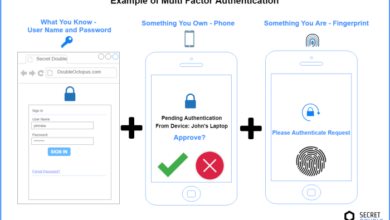
The psychology of phishing attacks is a fascinating and alarming field. It delves into the ways cybercriminals exploit human vulnerabilities to gain access to sensitive information. Phishing attacks aren’t just about technical vulnerabilities; they’re about understanding how people think and how they can be manipulated.
Imagine receiving an email that seems to be from your bank, urging you to update your account information. This email might trigger feelings of urgency, fear, or even trust, making you more likely to click on a malicious link. This is the essence of phishing, where psychology plays a crucial role in determining its success.
This blog post will explore the psychological principles behind phishing attacks, analyzing how they exploit our cognitive biases, emotions, and social instincts. We’ll delve into the tactics used by attackers and discuss effective countermeasures to protect ourselves from these insidious threats.
Understanding Phishing Attacks
Phishing attacks are a prevalent form of cybercrime that prey on human vulnerabilities to steal sensitive information. These attacks involve deceptive tactics designed to trick individuals into revealing confidential data, such as login credentials, credit card details, or personal information.
The success of phishing attacks hinges on understanding and exploiting human psychology.
Psychological Principles Exploited in Phishing Attacks
Phishing attacks leverage various psychological principles to manipulate victims into divulging sensitive information. These principles include:
- Social Proof:Phishing attacks often exploit the tendency of individuals to conform to the actions of others. For example, a phishing email might claim that a large number of users have already clicked on a link or provided their information, creating a sense of legitimacy and urgency.
- Scarcity:Creating a sense of urgency and limited availability can influence individuals to act impulsively. Phishing attacks might use phrases like “limited-time offer” or “exclusive access” to trigger a fear of missing out and encourage immediate action.
- Authority:Phishing attacks frequently masquerade as legitimate organizations or authorities to gain trust. For instance, an email might appear to be from a bank, government agency, or a well-known company, leading individuals to believe it is authentic.
- Reciprocity:Phishing attacks can exploit the principle of reciprocity by offering something seemingly valuable in exchange for personal information. This might involve fake surveys, discounts, or free gifts, making individuals feel obligated to reciprocate.
Common Phishing Tactics
Phishing attacks employ a range of tactics to deceive victims. Some of the most common tactics include:
- Spoofed Emails:Phishing emails often mimic the look and feel of legitimate emails from trusted sources. They may use logos, branding, and language similar to the real organization to create a sense of authenticity.
- Malicious Links:Phishing emails typically contain malicious links that redirect users to fake websites designed to steal their information. These websites may look identical to legitimate ones, but they are actually controlled by the attackers.
- Phone Scams:Phishing attacks can also occur over the phone, where scammers impersonate legitimate organizations or individuals to extract sensitive information. They might use tactics like spoofed caller IDs and high-pressure sales techniques to convince victims.
- Social Media Phishing:Phishing attacks can target users on social media platforms by creating fake accounts, sending malicious messages, or posting links to fake websites.
Social Engineering in Phishing Attacks
Social engineering plays a crucial role in phishing attacks. It involves manipulating individuals into performing actions that benefit the attacker. Phishing attacks often use social engineering techniques to build trust, create a sense of urgency, and exploit psychological vulnerabilities.
- Pretexting:Phishing attacks may involve creating a believable story or scenario to gain access to information. For example, an attacker might impersonate a tech support representative to convince a victim to provide remote access to their computer.
- Baiting:Phishing attacks can offer something seemingly valuable to entice victims into clicking on a link or providing their information. This might involve free downloads, discounts, or exclusive content.
- Scare Tactics:Phishing attacks may use fear and intimidation to pressure victims into taking immediate action. For example, an attacker might claim that the victim’s account has been compromised and needs to be secured immediately.
Psychological Factors Influencing Susceptibility: The Psychology Of Phishing Attacks

Understanding the psychology behind phishing attacks is crucial to mitigating their impact. By understanding the psychological factors that make individuals vulnerable, we can develop more effective security measures and educational programs to combat these threats.
Trust and Authority
Phishing attacks often exploit our inherent trust in authority figures and familiar institutions. Attackers leverage this trust by impersonating legitimate organizations, such as banks, government agencies, or well-known companies. For example, a phishing email might appear to be from a bank, urging the recipient to update their account information or verify their identity.
This creates a sense of urgency and a belief that the email is genuine, leading the recipient to provide sensitive information unknowingly.
Scarcity and Urgency
Attackers often use scarcity and urgency tactics to manipulate victims into acting quickly and impulsively. They might create a sense of limited-time offers, exclusive deals, or urgent security threats, making the victim feel pressured to act immediately without thinking critically.
This can lead them to overlook red flags and fall prey to the attack. For instance, a phishing email might claim that the recipient’s account is about to be suspended unless they take immediate action.
Fear and Anxiety
Fear and anxiety are powerful emotions that can cloud judgment and make individuals more susceptible to manipulation. Phishing attackers often prey on these emotions by creating a sense of fear or urgency, making victims feel vulnerable and inclined to act impulsively.
For example, an email claiming that the recipient’s computer is infected with a virus might trigger fear and anxiety, prompting them to click on a malicious link to “fix” the problem.
Curiosity and Greed
Curiosity and greed can also play a role in phishing attacks. Attackers might create enticing offers, such as free gifts, discounts, or opportunities to earn money quickly, to pique the victim’s interest and curiosity. This can lead them to click on malicious links or provide personal information in hopes of receiving something valuable.
For example, a phishing email might offer a free gift or a substantial discount on a popular product, tempting the recipient to click on a link to claim their prize.
Cognitive Biases and Phishing

Our brains are constantly trying to make sense of the world around us, and we often rely on shortcuts or mental heuristics to help us make decisions quickly. These shortcuts, known as cognitive biases, can be helpful in many situations, but they can also make us vulnerable to phishing attacks.
Confirmation Bias
Confirmation bias is the tendency to favor information that confirms our existing beliefs while ignoring or downplaying information that contradicts them. In the context of phishing attacks, this bias can lead individuals to trust phishing emails or websites that align with their pre-existing beliefs or expectations.
For example, if someone is expecting a package delivery, they might be more likely to click on a phishing email that appears to be from the shipping company, even if the email contains suspicious elements.
Phishing attacks rely on manipulating our trust and sense of urgency. They often mimic legitimate websites or services, hoping to trick us into revealing sensitive information. This is similar to how app store search ads can exploit our desire for convenience and the latest apps, tempting us to download potentially malicious software.
Understanding the psychological tactics behind both phishing and app store ads helps us stay vigilant and make informed decisions about what we click on and download.
Anchoring Bias
Anchoring bias occurs when we place too much emphasis on the first piece of information we receive, even if it is irrelevant or inaccurate. In phishing attacks, attackers can use this bias to influence their victims’ decisions by providing an initial anchor that sets the stage for their attack.
For example, a phishing email might start with a seemingly legitimate request, such as a password reset, before introducing a malicious link or attachment. This initial request can act as an anchor, making the victim more likely to trust the subsequent information in the email, even if it is suspicious.
Phishing attacks prey on our desire for shortcuts and trust. It’s a reminder that even in the digital world, we need to be mindful of what we’re clicking on. Just like tending a garden, nurturing healthy online habits takes time and attention.
I’ve learned this firsthand from my first garden, where I’ve discovered that patience and vigilance are key to success, what I’ve learned so far from my first garden. Similarly, with online security, a little extra care goes a long way in protecting ourselves from the digital weeds that can threaten our peace of mind.
Availability Heuristic
The availability heuristic is a mental shortcut that leads us to overestimate the likelihood of events that are easily recalled or vivid in our minds. In phishing attacks, attackers can exploit this bias by using emotionally charged language or imagery to make their attacks more memorable and therefore more likely to be believed.
For example, a phishing email might use a subject line that evokes fear or urgency, such as “Your account is about to be suspended!” or “Urgent security alert!” This can make the email seem more important and increase the likelihood that the victim will click on the link or attachment.
Understanding the psychology behind phishing attacks is crucial for protecting ourselves online. These attacks often prey on our trust and fear, making us more susceptible to falling victim. For instance, a recent news article hampton financial corporation announces the appointment of new ceo of its oxygen working capital subsidiary might seem innocuous, but it could be used as a springboard for a phishing attack.
By leveraging our curiosity about a relevant topic, attackers can lure us into clicking malicious links or providing sensitive information. Staying vigilant and verifying information before clicking is essential to staying safe in the digital world.
Social Proof
Social proof is a psychological phenomenon where individuals are more likely to perform an action if they see others doing it. In phishing attacks, attackers can use social proof to increase the credibility of their attacks by creating a sense of legitimacy or popularity.
For example, a phishing website might display fake testimonials or endorsements from supposed satisfied customers. This can make the website seem more trustworthy and increase the likelihood that victims will provide their personal information.
Phishing Attack Strategies and Tactics

Phishing attacks, while relying on the same core psychological principles, often employ different strategies and tactics to exploit human vulnerabilities. Understanding these variations is crucial for individuals and organizations to develop effective defenses.
Spear Phishing
Spear phishing is a highly targeted form of phishing attack. Attackers gather detailed information about their victims, including their job titles, interests, and social connections, to craft personalized messages that appear legitimate. This strategy exploits the psychological principle of social proof, as victims are more likely to trust messages that appear to come from someone they know or an organization they are familiar with.
Whaling
Whaling targets high-profile individuals, such as CEOs, executives, or celebrities, aiming to gain access to sensitive information or financial resources. This tactic leverages the scarcity principleby exploiting the perceived value and exclusivity associated with these individuals. Attackers often create elaborate schemes to gain trust and exploit the perceived power dynamics.
Clone Phishing
Clone phishing attacks involve replicating legitimate emails or websites, creating a sense of familiarity and urgency. Victims are more likely to trust a website or email that appears identical to one they have previously interacted with. This tactic exploits the familiarity bias, as people tend to be more trusting of things they recognize.
Pharming
Pharming attacks redirect users to fake websites by manipulating DNS settings or exploiting vulnerabilities in web browsers. This tactic exploits the trust in authorityprinciple, as victims are often unaware that they are being redirected to a malicious website. They may unknowingly enter sensitive information into a fake website that looks identical to the real one.
Smishing
Smishing attacks use SMS messages to deceive victims into providing sensitive information. These messages often appear to be from legitimate sources, such as banks or government agencies, and create a sense of urgency or fear. This tactic exploits the fear of missing outand the fear of social rejectionby creating a sense of urgency and social pressure.
Vishing
Vishing attacks use phone calls to deceive victims into providing sensitive information. Attackers often impersonate legitimate organizations, such as banks or government agencies, and use social engineering techniques to gain trust and obtain information. This tactic exploits the authority biasand the reciprocity principleby creating a sense of urgency and using persuasive language to manipulate victims.
Countermeasures and Mitigation Strategies
Phishing attacks, while a significant threat, are not insurmountable. Effective countermeasures and mitigation strategies can significantly reduce susceptibility and protect individuals and organizations from falling victim to these malicious schemes. This section explores various approaches, emphasizing the psychological principles that underpin their success.
User Education and Awareness Training
The first line of defense against phishing attacks is user education and awareness training. These programs equip individuals with the knowledge and skills to identify and avoid phishing attempts. By understanding the tactics employed by phishers, users can develop a critical mindset and learn to scrutinize suspicious emails, websites, and messages.
- Recognize common phishing indicators:Training should highlight common red flags, such as suspicious sender addresses, grammatical errors, urgent requests for personal information, and links that don’t match the expected website.
- Practice skepticism and verification:Users should be encouraged to question the authenticity of any request for sensitive information, even if it appears to come from a trusted source. Verification techniques, such as hovering over links before clicking or contacting the organization directly through known channels, are essential.
- Promote a culture of awareness:Organizations should foster a culture of security awareness by regularly communicating phishing threats and best practices. This includes incorporating phishing education into onboarding programs, conducting periodic training sessions, and using real-world examples to illustrate the dangers.
Security Software and Tools
Security software and tools play a crucial role in mitigating phishing attacks by providing automated protection and detection capabilities. These tools act as a second line of defense, supplementing user awareness and vigilance.
- Anti-phishing filters:These filters are designed to identify and block known phishing websites and emails. They use various techniques, such as analyzing email headers, URL patterns, and website content, to detect malicious activity.
- Anti-malware software:Anti-malware software protects users from malicious software, including phishing kits, which are used to create and distribute phishing attacks. It scans files and websites for known malware and can block or quarantine infected files.
- Spam filters:Spam filters help reduce the number of phishing emails that reach users’ inboxes. They analyze email content and sender information to identify and filter out suspicious messages.
Strong Password Practices
Strong password practices are fundamental to security and can significantly reduce the impact of phishing attacks. Phishers often target accounts with weak or easily guessable passwords. By implementing strong password policies, organizations can make it significantly harder for attackers to compromise accounts.
- Use complex and unique passwords:Encourage users to create passwords that are at least 12 characters long, combining uppercase and lowercase letters, numbers, and symbols. Each account should have a unique password.
- Avoid common or easily guessed passwords:Discourage the use of easily guessed passwords, such as names, birthdays, or common phrases. Password managers can help users generate and store strong, unique passwords for different accounts.
- Regularly change passwords:Organizations should enforce periodic password changes to minimize the risk of compromised passwords being used for extended periods.
Multi-Factor Authentication, The psychology of phishing attacks
Multi-factor authentication (MFA) adds an extra layer of security by requiring users to provide multiple forms of authentication before granting access to an account. Even if phishers obtain a user’s password, they will be unable to access the account without the additional authentication factor.
- Time-based one-time passwords (TOTP):TOTP generates a unique code that expires after a short period. Users can access these codes through authenticator apps or hardware tokens.
- Push notifications:MFA can be implemented using push notifications sent to a user’s smartphone or other trusted device. Users must approve the login request before gaining access.
- Biometric authentication:Biometric authentication methods, such as fingerprint scanning or facial recognition, can provide a highly secure form of MFA.
Phishing Simulation Tests
Phishing simulation tests are a valuable tool for assessing the effectiveness of user education and awareness training programs. These tests involve sending simulated phishing emails to employees and monitoring their responses. The results provide valuable insights into user behavior and help identify areas for improvement.
- Realistic scenarios:Simulation tests should use realistic phishing scenarios to mimic real-world attacks. This ensures that users are exposed to the types of phishing attempts they might encounter.
- Data analysis and feedback:Organizations should analyze the results of simulation tests to identify patterns in user behavior and areas where training needs to be strengthened. Feedback should be provided to users who clicked on phishing links or provided sensitive information.
- Continuous improvement:Phishing simulation tests should be conducted regularly to assess the effectiveness of training programs and identify emerging threats. The results should be used to refine training materials and improve overall security awareness.
Future Trends in Phishing Attacks
The landscape of phishing attacks is constantly evolving, driven by advancements in technology and the changing tactics of cybercriminals. As technology becomes more sophisticated, so too do the methods employed by attackers to deceive unsuspecting victims. This section will explore some of the emerging trends in phishing attacks, focusing on the role of artificial intelligence (AI) and machine learning (ML), the increasing sophistication of attacks targeting specific individuals or organizations, and the growing prevalence of phishing attacks on mobile devices.
Understanding these trends is crucial for individuals and organizations alike to develop effective countermeasures and mitigation strategies.
The Use of AI and ML in Phishing Campaigns
AI and ML are increasingly being used to enhance the effectiveness of phishing attacks. Attackers are leveraging these technologies to automate various aspects of their campaigns, including:
- Target identification and selection:AI algorithms can analyze vast amounts of data to identify potential victims based on their online behavior, demographics, and other factors. This allows attackers to create highly targeted phishing campaigns that are more likely to succeed.
- Phishing email generation:AI can be used to generate realistic and convincing phishing emails that mimic legitimate communications. This includes crafting persuasive subject lines, writing compelling email content, and even creating fake websites that look identical to the real ones.
- Automated phishing campaigns:AI and ML can automate the entire phishing process, from identifying targets to sending emails and managing responses. This allows attackers to launch large-scale phishing campaigns with minimal effort.
The use of AI and ML in phishing attacks poses significant challenges for defenders. It makes it more difficult to detect and prevent these attacks, as they are becoming increasingly sophisticated and personalized.
Sophisticated Phishing Attacks Targeting Specific Individuals or Organizations
Attackers are increasingly targeting specific individuals or organizations with highly customized phishing campaigns. These campaigns are often based on extensive research and intelligence gathering, allowing attackers to tailor their messages and tactics to maximize their chances of success.
- Spear phishing:This type of phishing attack targets specific individuals with highly personalized emails that appear to come from a trusted source. Attackers often use social engineering techniques to manipulate victims into clicking on malicious links or providing sensitive information.
- Whaling:This type of phishing attack targets high-profile individuals, such as CEOs, executives, or celebrities, with the goal of gaining access to sensitive information or financial resources.
- Targeted attacks against organizations:Attackers may target specific organizations with phishing campaigns designed to steal sensitive data, disrupt operations, or gain access to critical systems.
These sophisticated phishing attacks are often difficult to detect and prevent because they are highly customized and exploit vulnerabilities specific to the target.
The Growing Prevalence of Phishing Attacks on Mobile Devices
With the increasing use of mobile devices for personal and professional purposes, phishing attacks are becoming more prevalent on these platforms. Attackers are exploiting vulnerabilities in mobile operating systems and apps to gain access to sensitive information, such as login credentials, financial data, and personal contacts.
- SMS phishing (smishing):Attackers use SMS messages to lure victims into clicking on malicious links or providing sensitive information. These messages often mimic legitimate communications, such as notifications from banks or delivery services.
- Mobile app phishing:Attackers create fake mobile apps that look similar to legitimate ones, but contain malicious code that can steal data or gain unauthorized access to the device.
- Mobile website phishing:Attackers create fake websites that look identical to legitimate ones, but are designed to steal login credentials or other sensitive information.
The growing prevalence of phishing attacks on mobile devices presents a significant challenge for individuals and organizations. Mobile devices are often more vulnerable to phishing attacks than desktop computers, as they may have weaker security features and users may be less aware of the risks.






